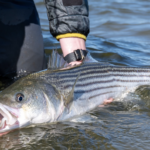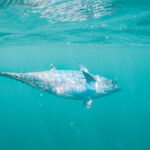
Talkin’ Striped Bass Spawn Dynamics
Consistent spawning production is paramount to a fishery’s long-term health. Many environmental factors are suspected
Catch and Release of Striped Bass
We have been doing angler workshops up and down the coast for the last few months. We visited Massachusetts, Rhode Island, Connecticut, and New Jersey to speak with anglers about their experiences. A big part of these meetings is the feedback from the several hundred participants. A few different topics rose to the surface in each location. One of those topics was catch and release mortality of striped bass.
We have to assume that this is in response to the latest graph on catch and release mortality and the newfound hyper focus on the issue. Let’s take a look at this information and possible motivation for the interest before we get into the science of catch and release.

Here’s the chart from the latest stock assessment. In 2017 recreational dead release exceeded recreational harvest. How did this happen? There is a standard percentage (9%) applied to the number of fished released. Essentially, recreational releases are estimated. That number is multiplied by .09 and you have the dead releases. As any recreational striped bass fisherman knows, our sector is deciding to release more stripers than ever before.
Releases along the Atlantic Coast rose from 38% of the catch in the early 1980s to 93% by the early 1990s (Diodoti and Richards 1996). Releases accounted for 91% of the Atlantic coast’s recreational catch during 1998 (United States Department of Commerce’s Marine Recreational Fisheries Statistics Survey or USDOC MRFSS, 1997).
We are trying to be more conservation minded by practicing catch and release, but the 9% average applied to the numbers obviously grows release mortality as we decide to release more fish. It is just math.
The real question that I’m asking is “Why is it so important now?” It didn’t seem to matter so much in 2006 when the catch and release mortality was substantially higher? Why are folks focusing on it so much now?
Occam’s Razor is a theory that suggests when several different explanations exist, the one with the least speculation is usually correct. Well, catch and release mortality matters now because the folks who want to keep harvesting are looking for loopholes to exploit via conservation equivalency. If a 17% reduction is required to stop overfishing, it can be accomplished in several ways. Rather than meaningful reductions, there will be an attempt to cut the release mortality. It might look good on paper, but the reality is that conservation equivalency is giant loophole for the folks who think striped bass are just fine. It is the low hanging fruit but also the least quantifiable. Commercial anglers provide tags, weights, and checkins. Their totals are very accurate compared to ours. You can monkey around with release numbers without taking a real cut. Like I said, Occam’s Razor. If that’s wrong, then why didn’t release mortality matter in 2006?
All that said, we have to do better and lower that number because it is what is best for the fish. What’s the best way to do better? Learn the real science and apply it to our daily fishing lives.
Honestly, when we asked the question, “What is the leading cause of mortality when you catch and release striped bass?” the comments were all over the place. People clearly cared, but their answers were based on personal experience and not science. That isn’t helping the fish or proper management. Our goal is to present this information so we can get everyone on the same page before the critical ASMFC meeting on August 8.
We believe in the facts. Peer reviewed, scientific studies on catch and release mortality of striped bass are really hard to find online. That’s why we are posting the ones we found on our website. Link 1 Link 2
The Facts
The leading cause of mortality in catch and release fishing for striped bass is physical injury from deep hooking.
PHYSICAL INJURY
These studies have documented that striped bass deep-hooked with J-style bait hooks will die approximately 50% of the time regardless of any other factor.
Results from DNR Catch-and-Release Studies
Mortality Rate of Striped Bass Deep-hooked with J-style Hooks
Year
1995 57.7%
1996 41.0%
1997 56.3%
1999 53.1%
2000 58.3%
Deep hooking with bait and J hooks is absolutely lethal.
“Shallow-hooked striped bass caught at high salinities from June through October in Chesapeake Bay died at a rate of 3.5%, while 53.1% of striped bass deeply hooked with J-style bait hooks died (Lukacovic 2000).”
We all know that circle hooks are not a silver bullet. Fish can be deep hooked with a circle hook but the location of the deep hooking is actually less lethal than the location of deep hooking from a J hook.
All deep hooked fish that died were necropsied to determine hook location at death and to document internal mechanical damage. Post mortem examination of dead fish, deep hooked with J-style hooks (N=14), consistently (as in previous Maryland DNR studies) exhibited profuse internal hemorrhage from puncture wounds to liver and/or heart. All deep hooked J-style hooks were oriented either ventrally or laterally in the visceral cavity. Dead fish, deep-hooked with circle hooks (N=5), also showed significant internal hemorrhage, tears in the esophagus and stomach, but not puncture wounds to liver or heart.
Necropsies of striped bass deep-hooked with J-style bait hooks that died in this study showed the point oriented ventrally or laterally 100% (N=14) of the time. Lukacovic (1999) reported J-style bait hooks were oriented ventrally 67.4% (N=43) of the time. Lukacovic and Uphoff (1997) reported that hooks were oriented ventrally 77.5% (N=40) of the time in dead striped bass deep hooked with standard bait hooks. Non-offset circle hooks orient the point away from the direction of travel when the line is pulled tight. The point does not penetrate organs as a standard bait hook with its point facing in the direction of travel. Only five striped bass deep hooked with circle hooks died, but necropsies showed tears in the esophagus were caused by the outside bend of the hook not the point. Dissections of striped bass deep hooked with standard bait hooks showed points penetrating liver and/or heart in most cases
With circle hooks, even deep hooked fish have lower mortality because the angle of the hook limits hitting critical internal organs. The other interesting fact was that smaller fish are generally more competitive and therefore more aggressive. The deep hooking rates for smaller fish were higher on average than larger ones. Please, don’t use J hooks when fishing bait. It is clearly better for the fish. You’ll figure out how to use a circle hook, give it time.
Other Stressors
There are three other stressors for mortality of catch and release striped bass. Those are salinity, water temp, and air temp. Dissolved O2 is also a factor but it goes hand in hand with salinity and water temp. Also due to temperature-caused summer-time stratification of Bay waters there is less DO in deeper waters. Hence, there is less dissolved O2 in deep water with no salinity and warm temps. Shallow areas are often blessed with O2 through diffusion (wave action). Cooler water can hold more dissolved O2. These three stressors are interactive. That is, a combination of all three are potentially lethal. Let’s do a deep dive on this so everyone can understand the data.
Believe it or not, salinity has an enormous impact on catch and release fishing of striped bass. Essentially, fresh water in conjunction with high water temps is awful even for shallow hooked fish.
Studies done in Maryland’s Chesapeake Bay have shown when salinity is present at levels of 2 parts per thousand (ppt, 0.2%) or greater water temperature does not influence stress related mortality of striped bass. Statistical analysis of more than 1300 striped bass used in MDDNR studies (1996-2000) in which water temperature ranged from 59F to 83F did not detect an influence of water temperature on mortality. All of these studies were conducted in water with at least 2 parts per thousand salinity.. A study in California with fresh water acclimated striped bass showed enhanced recovery if they were placed in brackish water (Cech et al. 1996).
Studies have shown that in fresh water (no salinity) such as the Susquehanna Flats, increasing water temperature will increase release mortality among shallow-hooked striped bass.
Susquehanna Flats Catch-and-Release Study- 1998
Water Temperature (F) Mortality Rate
57-59F 0.15%
61-62F 4.2%
64-71F 16.4%
Air temperature also has an impact. But when AIR temperature and no salinity are combined (interactive) the numbers are almost unbelievable. There is further research, Wilde et al. paper which is an aggregation of seven different studies, that shows the consistency of the research of C&R mortality in fresh water with increasing temperatures. Release mortality can exceed 67% – that’s 2/3s of released fish that can die under those circumstances when water temp is high in zero salinity.
***Salinity is present in this chart. The Susquehanna Flats had no salinity****
Mortality Rate of Shallow-Hooked Striped Bass
Chesapeake Bay 1999 Fresh Water in Tennessee 1998 *
Air Temp. (F) Mortality Rate Air temp. (F) Mortality Rate
<95F 0.8% 59F 14%
>95F 17.2% 88F 67%
***Please Note***
Under 95-degree air temperatures with salinity, shallow hooked fish in the Chesapeake have a mortality rate of .8%. Over 95-degree air temps push the mortality number to over 17%. This is related to time out of water. Has anyone ever thought it would be a good idea to keep the fish in air the water during the release? There are #keepemwet movements all over social media. This isn’t a new idea and completely solves high air temp mortality unless you are in a large boat with very high gunnels. The thing to understand here is both of these numbers are factored into the 9% standard catch and release mortality rate that is applied to every single fish we release. However, in freshwater and high air temps, mortality rates rise to an unbelievable 67% at just 88 degrees.
There is also a relationship between the variance of air temp and water temp. If the difference is great than 6 degrees Celsius, (approx. 12f) the fish can sustain injury to the gills. This is easily solved by keeping the fish in the water during the release.
Conclusions
Deep hooking is the number one cause of striped bass mortality. While circle hooks are not a silver bullet, they are still effective. Even if a fish is deep hooked with a circle hook, it has a higher survival rate than those deep hooked with a J hook.
Water temp, air temp, and salinity are interactive. Addressing just one of these factors isn’t nearly as effective as addressing them all. Shallow hooking mortality jumps to 16.4% with zero salinity at about 70-degree water temp. Shallow hooking mortality is .8% with air temps under 95 degrees and 2ppt salinity present (Ocean water is 30ppt). It jumps to 17.2% over 95-degree air temp. IT JUMPS TO 67% with no salinity at 88 degree water temp.
If we truly want to address catch and release mortality, we need to focus on areas with no salinity when water temps are 80 and above.
This creates an issue for the Maryland portion of the Chesapeake Bay. Right now, the big concentrations of fish are in areas with no salinity. Specifically, above the mouth of the Chester River are areas of great concern. Striped bass are packed in that area and being targeted daily.

You can check out a video of a pound net on facebook This is a result of hypoxic (no dissolved oxygen) water moving in on a pound net in an area with no salinity.
Currently Maryland DNR is discussing having “no fishing times” between 10 AM and 4PM during high temperatures. This would allow six pack charters to go out in the morning or in the afternoon. It would also allow commercial fishing to operate at status quo. It would do almost nothing to help the fish in freshwater and would limit fishing in other areas where salinity and dissolved oxygen are present. In the spring and winter, the Chesapeake sees release mortality at 1%. Doing anything with limiting access to the pre-season catch and release fishery is about as useful as a screen door on a submarine.
If you recall from the previous stats, catch and release mortality rises to about 17% at 95-degree air temperature. This can be avoided by keeping fish in the water. Catch and release mortality skyrockets to 40% at WATER TEMPS of 80 degrees in freshwater. What’s really going on here? You can see from the video, this does little to address the real issues. Low salinity and water temperature (low dissolved oxygen) are by far greater stressors. Is Maryland looking to monkey with the stats to push their own agenda? We will leave that up to you to decide. The science (their own science) seems to point to a much more complex relationship that can be addressed. In fact, it should be addressed. The interactive stressors don’t apply to much of the coast. However, circle hooks would be a vast improvement in successfully releasing fish. We have the science. The litmus test will be if we use it. We are sure that Maryland will push for conservation equivalency. Let’s see if they actually address the issue, or cherry pick science to push the species to the limit.

Consistent spawning production is paramount to a fishery’s long-term health. Many environmental factors are suspected

While the ASGA team is extremely proud of the community we’re building with the Guide

Feature Image: A false albacore being landed off Jupiter Florida by the Cheeky Fishing team,

Feature Photo: “Best Practices for Fishing Cobia Around Manta Rays” The Florida Manta Project is
We rely on our members and donations to keep fighting for a sustainable tomorrow in marine conservation.
By using this website, you agree to our use of cookies. We use cookies to provide you with a great experience and to help our website run effectively. To learn more, please review our privacy policy.
6 Responses
Thanks for putting together a clear and concise report and graphic.
Regrettably ALL recreational catch data is contrived and as a more eloquent colleague of mine once remarked “You can’t make chicken salad out of chicken sh**.” It’s almost like NMFS has used rec discard mortality as a easy reason for making their model numbers work. There are other things to consider, especially in the Chesapeake, and one of the most important is mycobacaterial mortality.
Two types of hooks, barbless and circle hooks, are known to reduce injury and mortality of released fishes. Barbless hooks reduce tissue damage and handling stress because they can be removed quickly and easily. Barbless hooks are popular in the freshwater trout fisheries and are becoming increasingly popular with saltwater anglers. A Florida study conducted on snappers and groupers demonstrated that catch rates are the same for barbed and barbless hooks. If barbless hooks are not available, simply use pliers to crimp or remove the barbs from regular hooks. A caveat is called for when using these types of hooks: after having hooked your quarry, don’t give the fish any slack, because it will be more likely to escape from barbless hooks than from regular hooks.
Excellent! Another fantastic post. I really enjoy reading this and the other content on here.